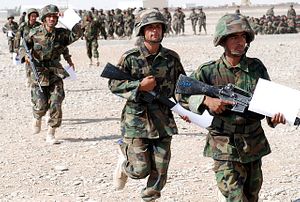Today, the Special Inspector General for Afghanistan Reconstruction (SIGAR) released its 26th Quarterly Report to Congress (I wrote about a previous SIGAR report here). The most striking revelation is that after six years of being publicly reported, Afghan National Security Forces (ANSF) data is now classified. This decision leaves the government watchdog SIGAR unable to publicly report on most of the $65 billion U.S.-taxpayer-funded efforts to build, train, equip, and sustain the ANSF. This includes Afghan troop numbers, salaries, training, equipment (including planes and helicopters), and infrastructure projects. Henceforth, this data will be in a classified appendix only available to officials with top-secret security clearances.
The report notes that over 140 SIGAR questions received classified or otherwise restricted responses. Here are some of the sample questions:
Please provide a broad definition of the terms “unavailable” and “present for duty” of ANSF.
How has the $25 million authorized by Congress for women in the Afghan army been used?
Please provide the total amount of funding that the United States has expended on Afghan National Police salaries for the current year.
Please provide details of DOD/NATO-funded contracts to provide literacy training to the ANSF, including: the cost of the contract(s) and estimated cost(s) to complete.
Please confirm that the Combined Joint Interagency Task Force-Afghanistan (CJIATF-A) is dissolved.
Please offer an assessment of the anti-corruption initiatives of Afghan Ministry of Defense and Afghan Ministry of Interior.
The New York Times reports that the reason behind the classification is concerns over the safety of Afghan and U.S. forces in the country. In a note to the inspector general John Sopko, Gen. John Campbell, commander of American forces in Afghanistan, states, “With lives literally on the line, I am sure that you can join me in recognizing that we must be careful to avoid providing sensitive information to those that threaten our forces and Afghan forces, particularly information that can be used by such opposing forces to sharpen their attacks.”
The New York Times editorial board has an acid response to this often-heard rationale:
“The threats that Afghan and American troops face in Afghanistan remain all too real. But it strains credulity to believe that insurgents would become more proficient fighters by poring over lengthy inspector general reports about an increasingly forgotten war. Classifying that information unreasonably prevents American taxpayers from drawing informed conclusions about the returns on a $107.5 billion reconstruction investment that, adjusted for inflation, has surpassed the price tag of the Marshall Plan.”
Perhaps one of the reasons is that with U.S. ground troops withdrawing, it is simply no longer possible to verify data on the ANSF and reconstruction efforts on the ground.
The SIGAR report also notes that despite more than a decade of multilateral efforts, achieving effective coordination of assistance to Afghanistan remains an elusive goal for the United States, other donors, and the Afghan government. The Afghan government is projected to have a $500 million budget shortfall; the domestic revenues missed budget targets by 26%, while Afghan government expenditures increased by 11%. The United States gave Afghanistan $100 million to help cover the fiscal gap. The United States Congress has appropriated nearly $107.5 billion for Afghanistan reconstruction. Of this amount, $15.3 billion remains in the funding pipeline for potential disbursement.

































